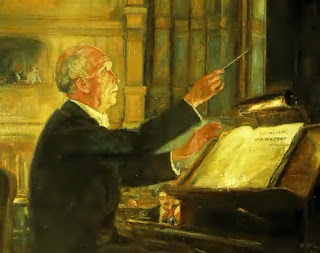The son of an acclaimed horn player, Strauss was a famous conductor as well as a composer, leading his own works and acclaimed performances of Wagner, Mozart and many others. He had a short baton, a small beat, a professional attitude, and a razor-sharp wit. (If you don't believe me, watch this footage of Dr. Strauss conducting a rehearsal of Der Rosenkavalier.) With that in mind, we present his
Ten Golden Rules For the Album of a Young Conductor
(originally written in 1925)
(originally written in 1925)
- Remember that you are making music not to amuse yourself, but to delight your audience.
- You should not perspire when conducting. Only the audience should get warm.
- Conduct Salome and Elektra as if they were by Mendelssohn: Faerie music.
- Never look encouragingly at the brass, except with a brief glance to give an important cue.
- But never let the horns and woodwinds out of your sight. If you can hear them at all, they are still too strong.
- If you think that the brass is now blowing hard enough, tone it down another shade or two.
- It is not enough that you yourself should hear every word the soloist sings. You should know it by heart anyway. The audience must be able to follow without effort. If they do not understand the words, they will go to sleep.
- Always accompany the singer in such a way that he can sing without effort.
- When you think you have reached the limits of prestissimo, double the pace.*
- If you follow these rules carefully, you will, with your fine gifts and your great accomplishments, always be the darling of your listeners.
Originally published in Reflections and Recollections by Richard Strauss. © 1949 Cambridge University Press.





